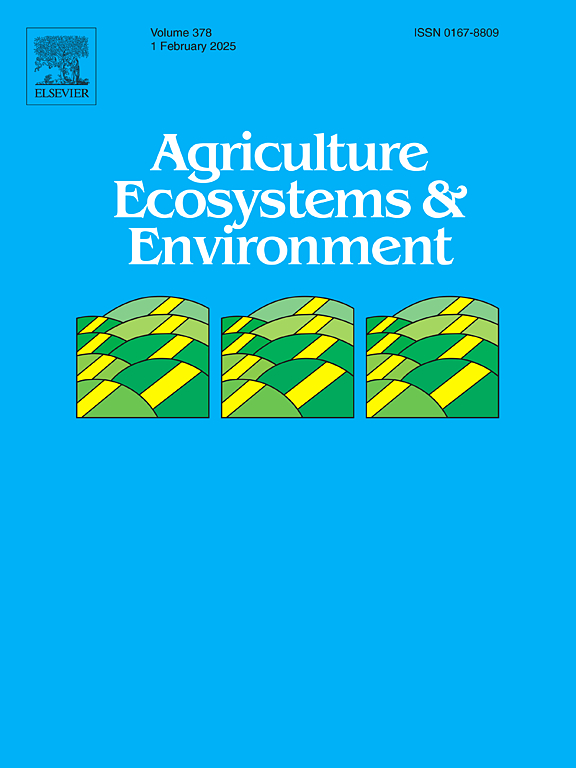Direct and cascading impacts of landscape heterogeneity and agrochemical use on multi-trophic biodiversity in the patchy agroecosystem
IF 6.4
1区 农林科学
Q1 AGRICULTURE, MULTIDISCIPLINARY
引用次数: 0
Abstract
Farmland biodiversity is declining globally due to intensified agricultural practices, landscape homogenization, and simplification. However, the direct and cascading effects of landscape heterogeneity and agrochemical use on various interacting taxa and trophic levels remain unclear. This study investigated the richness and abundance of taxa across trophic levels, including weeds, epigeic invertebrates, and birds, within a patchy agroecosystem in Pengzhou, Sichuan, China. Structural equation modeling was used to analyze the responses of multi-taxa and trophic levels to agrochemical use, edge density and cropland diversity, and quantify the direct and indirect effects therein. Results showed that landscape heterogeneity and agrochemicals influenced the abundance and richness of weeds, epigeic invertebrates, and birds through direct impacts and bottom-up cascading effects. Agrochemicals negatively affected weeds and invertebrates at lower trophic levels, while edge density had positive effects. Both factors also exerted cascading effects on invertebrates and birds, and the magnitude of net effects diminished as trophic level increased. Cropland diversity reduced weed and invertebrate abundance, likely through competition between weeds and crops and frequent soil disturbances during farming, but exerted positive effect on crop-feeding birds probably due to additional food supply. These findings reveal varied responses of trophic groups with distinctive traits in size, mobility, and resource utilization to landscape heterogeneity and agrochemical use, and highlight the importance of biotic interactions in regulating these ecological processes. This study indicates that reducing agrochemicals use alongside enhancing landscape heterogeneity can promote multi-trophic biodiversity and sustain ecosystem services in patchy agroecosystems.
斑块状农业生态系统中景观异质性和农用化学品使用对多营养生物多样性的直接级联影响
由于集约化的农业实践、景观同质化和简化,全球农田生物多样性正在下降。然而,景观异质性和农用化学品使用对各种相互作用的分类群和营养水平的直接和级联效应尚不清楚。本研究调查了四川彭州斑块状农业生态系统中不同营养水平分类群的丰富度和丰度,包括杂草、附生无脊椎动物和鸟类。采用结构方程模型分析了多类群和营养水平对农药使用、边缘密度和耕地多样性的响应,并量化了其直接和间接影响。结果表明,景观异质性和农药通过直接影响和自下而上的级联效应影响了杂草、附生无脊椎动物和鸟类的丰度和丰富度。农用化学品对低营养水平的杂草和无脊椎动物有负面影响,而边缘密度有积极影响。这两个因素也对无脊椎动物和鸟类产生级联效应,并且净效应的大小随着营养级的增加而减小。农田多样性减少了杂草和无脊椎动物的丰度,可能是由于杂草和作物之间的竞争以及耕作过程中频繁的土壤干扰,但可能是由于额外的食物供应,对以作物为食的鸟类产生了积极影响。这些发现揭示了具有不同规模、流动性和资源利用特征的营养类群对景观异质性和农用化学品使用的不同反应,并强调了生物相互作用在调节这些生态过程中的重要性。研究表明,减少农用化学品的使用和增强景观异质性可以促进多营养生物多样性,维持斑块农业生态系统的生态系统服务。
本文章由计算机程序翻译,如有差异,请以英文原文为准。
求助全文
约1分钟内获得全文
求助全文
来源期刊

Agriculture, Ecosystems & Environment
环境科学-环境科学
CiteScore
11.70
自引率
9.10%
发文量
392
审稿时长
26 days
期刊介绍:
Agriculture, Ecosystems and Environment publishes scientific articles dealing with the interface between agroecosystems and the natural environment, specifically how agriculture influences the environment and how changes in that environment impact agroecosystems. Preference is given to papers from experimental and observational research at the field, system or landscape level, from studies that enhance our understanding of processes using data-based biophysical modelling, and papers that bridge scientific disciplines and integrate knowledge. All papers should be placed in an international or wide comparative context.
 求助内容:
求助内容: 应助结果提醒方式:
应助结果提醒方式:


